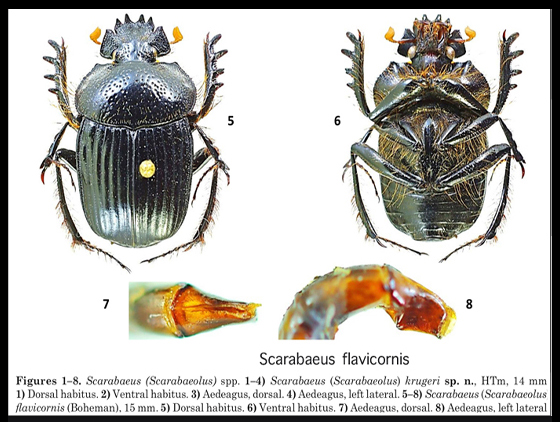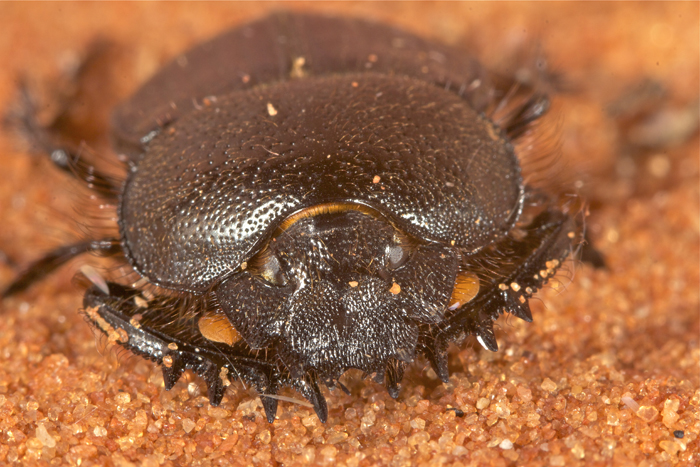
Please do

Description:
Large nocturnal telecoprid (ball-rolling) dung beetle.
Habitus black. Elytra flat, not prominently striated. Antennae orange.
Found in arid regions, Kalahari deep sands, outliers to east, Central Namib Desert, SW coast; South Africa, Namibia, Botswana, Zambia.
The recorded range of this species is from Lamberts Bay [32° 5’S 18°19’E] in the south (South Africa) to Liuwa plains [14°38’S 22°37’E] in the north (Zambia).
https://repository.up.ac.za/bitstream/h ... sAllowed=y
Scarabaeini
Taxonomy and morphology: The Scarabaeini comprise three genera, Scarabaeus, with 136 species, Pachylomera with two, and Pachysoma with
13 species. The tribe is characterized by members with the anterior margin of the head, which is sexdentate, comprising the quadridentate anterior margin of the clypeus and two lateral teeth formed by the anterior angles of the genae. Th e beetles have long legs for ball- rolling and/or fast running. Th e tibiae of the forelegs are quadridentate, although the proximal tooth may be represented by only a vestige. There are no fore tarsi. The species are mainly black although some show either red elytra or red patches on the elytra (some Scarabaeus, Pachysoma). A few are metallic-coloured (some Kheper). They vary in size from quite small (7.0 mm) to very large (48.5 mm).
Most of the species fly strongly but a number of desert taxa are flightless (including all the Pachysoma species).
Scarabaeus comprises four subgenera, the nominate subgenus, Kheper, Scarabaeolus and Sceliages.
The Scarabaeini comprise primarily coprophagous species. Th ey may be readily attracted to many dung types, or more specialized, with some also strongly attracted to carrion. Most species are active by day but some Scarabaeus, Scarabaeolus and Kheper are night-active. Whereas flightless species drag pellets and detritus, most flying species engage in ball-making and ball-rolling.
If ball-making and ball-rolling species form pairs at the dung, the males roll the ball with the female clinging to the side (Kheper, Scarabaeus (Scarabaeus)) or following behind (Scarabaeolus). When large numbers of Scarabaeini are active there is frequently combat between early arrivals at a dropping that have completed a ball and late arrivals that attempt to take possession of this ball. During such encounters, the object is to dislodge the incumbent from its defensive position on top of the ball or to deter the attacker by using the front legs to lift and flip the opponent away.
The ball may be rolled some distance before being buried in a burrow where it is used either for feeding or breeding.
Once a suitable pile of dung has been located, some species quickly sculpt a piece into a ball and start to roll it away along a straight path. The end destination for the ball is, at this point, unknown. The straight-line departure helps to minimize the time that the dung beetle spends near the dung pat, where foraging conspecifics congregate and frequently try to steal a ready-made ball. After some distance, the beetle finds a suitable patch of ground and buries itself together with its ball of dung. The ball is then slowly consumed in the safety of the ground.
Leaving a defined place might at first glance seem simple but is, as it turns out, impossible without an external directional reference—i.e. some form of compass. This is true even for ensuring progress away from a dung pile. Foraging dung beetles use a number of celestial compass cues to guide them along their straight tracks: the sun, the moon, the pattern of polarized light and even the Milky Way.
Nests of most Scarabaeini (Kheper, Scarabaeus (Scarabaeus)) comprise a chamber at the end of the burrow in which one or more brood pears are constructed and tended by the parent female.
Flight activity patterns may be related to the cooler conditions under which most species have been observed to fly, i.e. in the middle of the day under cooler conditions, but in the early morning, late afternoon, or at night under warmer conditions and, especially, after rainfall with its cooling effect on daily temperatures. At least some species are able to raise their body temperatures, enabling them to fly and exploit dung under cooler conditions.
Scarabaeolus:
Although recognition of the subgenus is not universal, of the 27 Scarabaeolus species, currently known, 24 show a regionally restricted distribution pattern centred on southern and southern central Africa. Furthermore, one observation of a Scarabaeus (Scarabaeolus) bohemani female following a male rolling a ball suggests that members of the subgenus may also show behavioral differences to Scarabaeus (Scarabaeus) species in which the female clings to the side of a ball being rolled by the male.


